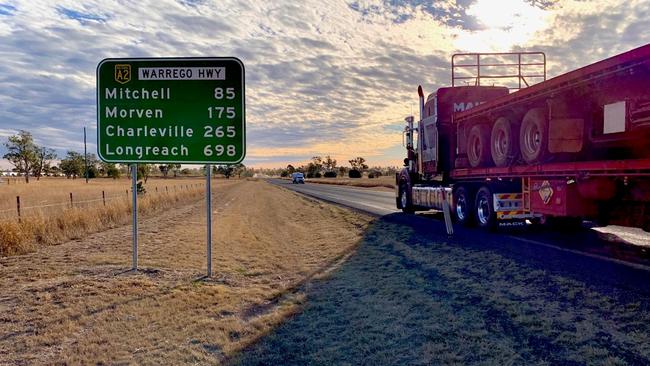Council budgets reveal spending on roads in Maranoa, Murweh, Paroo and Balonne council areas
South West Queenslanders know maintaining and developing road infrastructure is critical for all facets of life in the bush. Find out how your council’s spending on roads in the region compares to your neighbours.

Roma
Don't miss out on the headlines from Roma. Followed categories will be added to My News.
In a practical sense, the land of sweeping plains really means the land of sprawling road networks.
However, maintaining thousands of kilometres of road infrastructure under the persistent tread of massive trucks in a harsh and volatile landscape, is no easy feat.
Across South West Queensland, local councils have all handed down their budgets, which aim to provide for their community now, and set the regions up for future success.
Arguably one of the most important functions of South West Queensland’s local governments is maintaining and building reliable and safe transport networks.
The Maranoa, Murweh, Paroo and Balonne region are all home to sprawling arterial road networks, which virtually sustain the livelihood and economies of the region’s rural communities.
Accordingly, roads makes up the largest portion of capital expenditure in all those council’s budgets. In the Maranoa region, more than 50 per cent of budgeted capital expenditure will go towards roads and drainage projects. In the Balonne shire, roads spending makes up 46 per cent of capital expenditure, while in the Murweh and Paroo shires, roads spending makes up 36 and 33 per cent respectively.
Across the four regions, this year’s budgets will see more than $60m invested into capital road projects, to service more than 10,000km of road networks.
The Maranoa Regional Council, which totalled close to $42m dollars, on top of close to $4.5m of operating expenditure on roads.
The figure is nothing to baulk at, particularly for a regional council which brings in just shy of $50m per year from rates.
However, more than 80 per cent of the council’s capital works expenditure on roads is externally funded, through a range of state, federal and private assistance.
The Maranoa Regional Council will receive more than $30m from the Australian government as part of the Remote Roads Upgrade Pilot Program, Roads to Recovery Program, and Local Roads and Community Infrastructure Program.
The state government’s disaster recovery funding is also set to contribute to roads maintenance in the 2024/25 financial year, which is factored into the council’s operating expenditure.
The state government initiative, controlled by the Queensland Reconstruction Authority, provides funding to councils to help return infrastructure to exactly the way it was before a disaster.
The Maranoa Regional Council will receive funding for recovery works after rain and flooding in March and April of 2024, and bushfires in September through to November of 2023.
While the Murweh, Paroo, and Balonne shires don’t have as vast road networks as the Maranoa region, they stand at a disadvantage with more kilometres per capita. With a lower population, those councils generate less revenue through rates.
Close to 45 per cent of the Maranoa Regional Council’s revenue is generated through rates, while just over 10 per cent of the Paroo Shire Council’s revenue is generated through rates. The Balonne and Murweh shire council’s rates make up 23.9 per cent and 20.74 per cent of their total revenue respectively. For a larger scale example, the Toowoomba Regional Council is able to generate over 50 per cent of their revenue through rates.
The Maranoa region is home to close to 13,000 people, and has a rural road network of 5608km. However, the Paroo Shire is home to less than 1400 people, but manages a road network of 2346km.
In their 2024/25 budget, the Maranoa Regional Council has continued an existing policy, which assures rural ratepayers that all their rates go towards rural roads, mayor Wendy Taylor said.
Maranoa Regional Council deputy mayor and portfolio spokesman for rural roads, Cameron O’Neil, said roads are the arteries sustaining the Maranoa’s communities.
“Rural roads go beyond connectivity for economic benefit alone, they are also critical for connecting our rural communities for educational, health and social gatherings,” Mr O’Neil said.
“Safe roads are literally our social network more than just infrastructure.
“They are a critical link our primary producers, other businesses and major industries.
“With road tourism increasing, this is becoming increasingly important too.
“We face challenges managing the upkeep of the extensive network of roads over such a large and widely spread region with such a small ratebase.
“However Council is committed to resourcing them, continuing the policy where 100 per cent of rural rates is going to our roads network in our budget.
“With the challenges we face we do rely on the support of the State and Federal governments to maintain this vital network and constantly advocate for our region to ensure these challenges are heard.”




